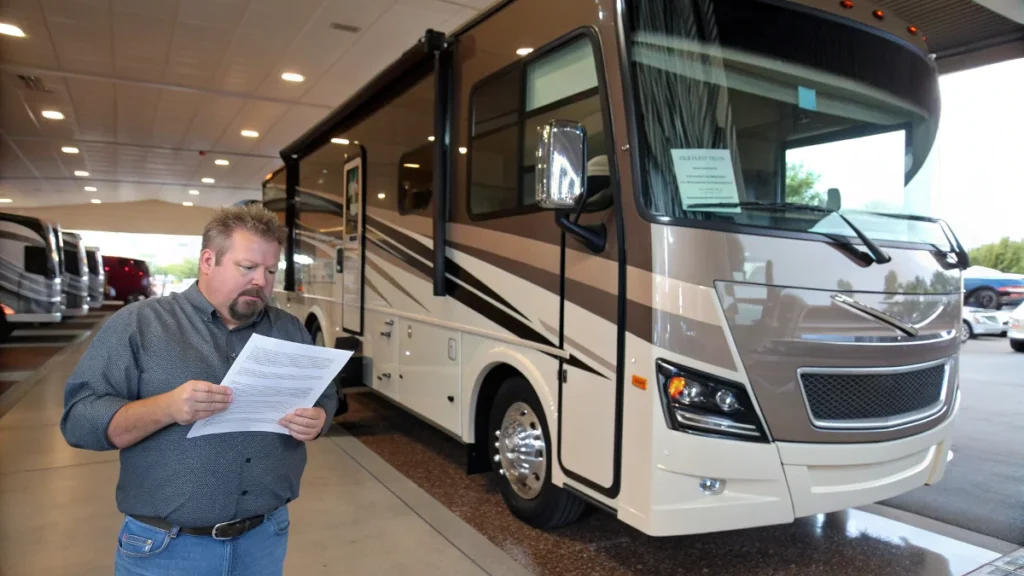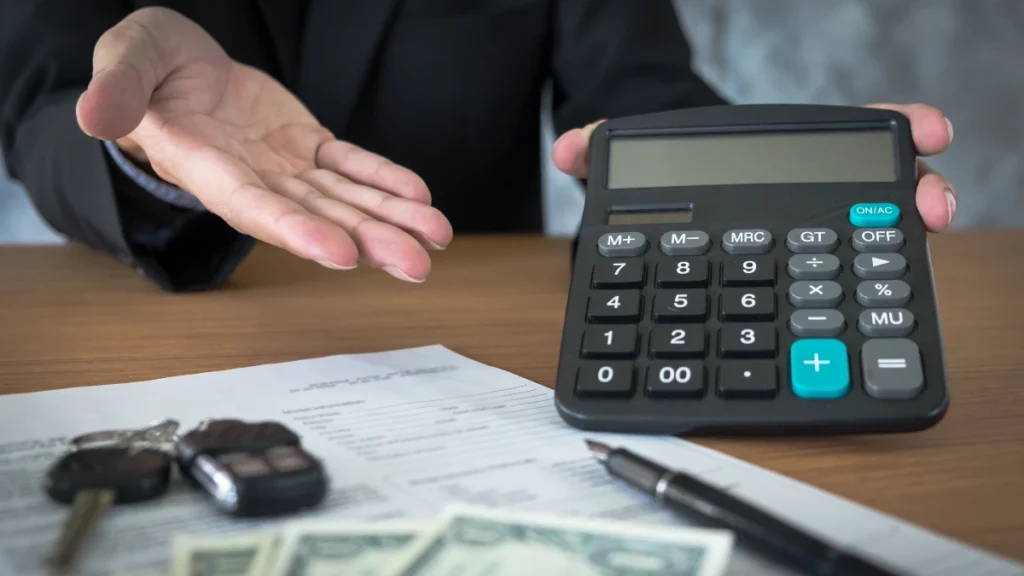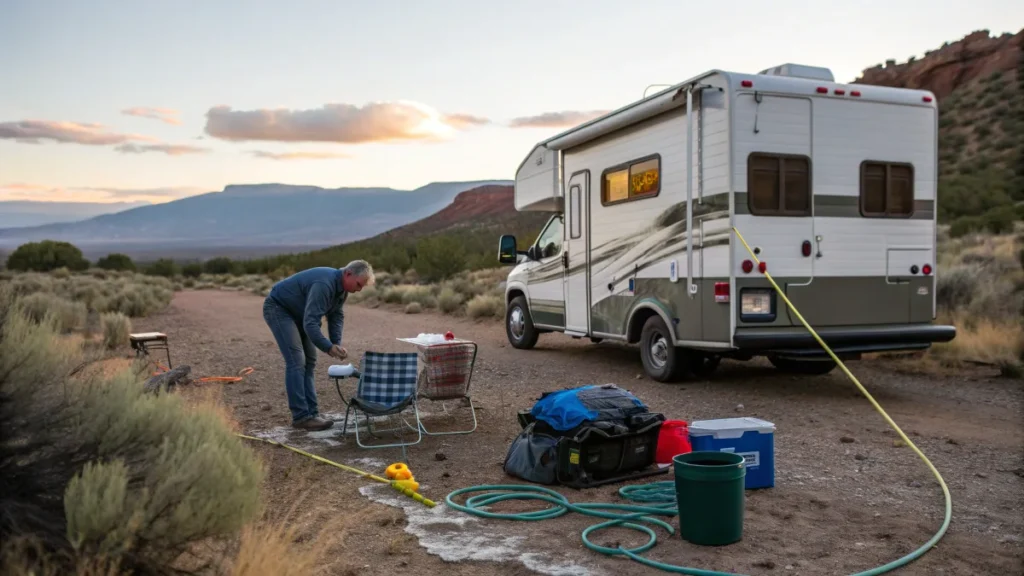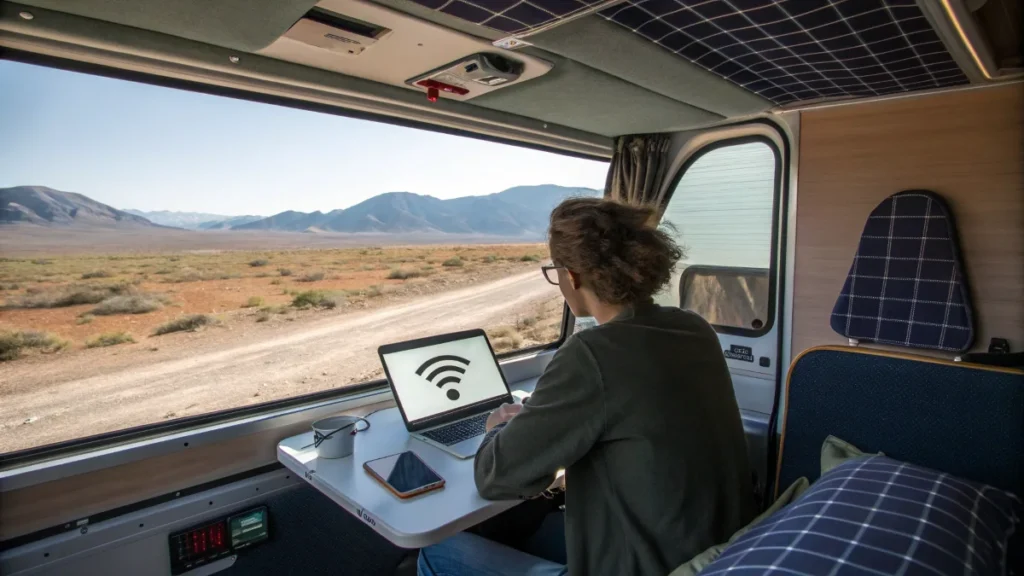One year ago, I sold 90% of my possessions, handed in my office keys, and hit the road for a life of “ultimate freedom” in a 40-foot RV. I had a perfect vision of scenic sunsets and campfires.
That vision lasted until my first $1,200 repair bill. It cracked during my first failed client call from a “connected” campground. It shattered during the first major argument in a rainy Walmart parking lot. The reality of full-time RVing isn’t the dream you’re sold.
This isn’t a guide to scare you off. This is the guide I wish I’d had. After 365 days, I learned five critical lessons that could have saved me over $10,000 and countless headaches.
Here is exactly what I’d do differently:
Mistake #1: Buying the Wrong RV (and Buying It New)

My dream RV was a 42-foot brand-new motorhome. It had all the bells and whistles. My reality was a wallet-draining lemon. This was my first and most expensive full-time RVing mistake.
The “New RV” Trap
Here’s the single biggest financial error you can make: buying a new RV.
An RV is not like a house. It does not go up in value. It’s a vehicle. The moment you drive it off the lot, the value plummets. Statistics show an RV loses about 20% of its value in the first year alone. By year three, a big Class A motorhome can be down 27% from what you paid.
I thought “new” meant “no problems.” I was dead wrong.
The “Shakedown” Nightmare
New RVs are famous for having problems. The first year is called the “shakedown” period. This is when you find all the things the factory built poorly.
In my first three months, I had a water leak under the sink, an electrical outlet that didn’t work, and a slide-out that got stuck. And guess what? You can’t just drop it at the dealer for a week. You live in it. This means you are either fixing it yourself or living in a repair shop parking lot.
The “Wrong Size” Fallacy
I thought bigger was better. More space, more comfort, right?
Yes, but that comfort comes at a huge cost. My 42-foot rig was a nightmare to drive and park. More importantly, it locked me out of the best places.
RV Size Matters: The Access Dilemma
National Parks
Many beautiful parks have length limits of 30-35 feet.
Scenic State Parks
Older, scenic parks? Forget it if you’re in a huge rig.
Free Boondocking
The best free spots are often down dirt roads you can’t take.
I had a comfortable box I couldn’t park in the places I wanted to see.
My “Do-Over” Plan
I would never buy another RV new or used without a Level 2 inspection from an NRVIA-certified inspector (National RV Inspectors Association).
Think of this like a home inspection, but for an RV. It’s a 165-point check that costs a few hundred dollars. That inspector could save you $10,000 by finding hidden water damage or a broken slide system that the dealer “missed.”
My new rule is simple: Buy used (2-5 years old), and always pay for an NRVIA inspection. Let someone else take the 20% depreciation hit and fix the factory’s mistakes.
Mistake #2: Underestimating the Real Cost of Full-Time RVing

Everyone tells you to save an “emergency fund.” No one tells you to have a separate “RV Catastrophe Fund.”
My first big mistake was the rig. My second was my budget. I thought I’d be saving a ton of money. My home mortgage was gone, but it was replaced by three new, wild costs: Fuel, Campgrounds, and Repairs.
The “Catastrophe Fund” vs. “Emergency Fund”
An emergency fund is for you. If you get sick or lose a client, you use this.
A catastrophe fund is for the rig. This is for when a slide-out motor dies, your AC unit breaks, or a tire blows. These are not “if” problems; they are “when” problems. They are part of the cost of full-time RVing.
I’ll show you my budget. I thought I’d spend about $2,500 a month. My reality was closer to $4,000. Why? Repairs.
Experts in 2025 confirm most full-timers spend between $1,600 and $5,000 per month. I didn’t budget for a $5,000 slide-out repair or a $1,500 power inverter issue.
The “Big 5” Hidden Costs
On top of repairs, I completely underestimated the “Big 5” costs that people forget:
The Obvious Cost
The Hidden Costs (Below the Surface)
Insurance
RV and tow-vehicle insurance is complex and more expensive than regular auto insurance.
Propane
This is your heat and hot water. In a cold month, you can burn through propane fast.
Maintenance
An oil change isn’t $60. It’s hundreds. A single new RV tire can be $500 or more.
Health Insurance
Your network is likely back home. You’ll be paying out-of-network prices or need an expensive national plan.
Internet
Good internet is not free. (More on that in a minute).
Boondocking Isn’t “Free”
I thought I’d save money by “boondocking” (camping for free on public land).
Well, “free” camping requires a very expensive setup. To live off-grid, you need a great solar panel system, lithium batteries, and a big inverter. That setup can cost $5,000 to $15,000. It pays for itself, but it is not free to start.
My new rule: Budget $200/month for just repairs, and don’t hit the road without $5,000 in a separate bank account. Trust me.
Mistake #3: Moving Too Fast (The “Vacation” Mindset)

In my first month, I saw 15 states. I remember almost nothing about them.
This is the “vacation” mindset. You have a limited time, so you have to see everything, right? Wrong. This isn’t a two-week vacation. This is your life. This was one of my biggest full-time RVing mistakes.
A “travel day” is an entire workday. You have to secure everything inside the RV, unhook water, sewer, and electric, drive for 4-5 hours (which is exhausting in a big rig), find your new spot, get level, and hook everything back up.
Doing that 2-3 times a week is a recipe for total burnout. As one RV blog puts it:
“The days when you move your RV will be hectic… You might not have the time or energy to do very much exploring once you get there.”
That is 100% true. I was too tired to explore.
Slowing Down Saves Your Sanity and Your Wallet
The solution is to slow down. The “A-ha!” moment for me was seeing the price difference.
A campground might be $70 per night. If you stay 30 nights, that’s $2,100. But that same campground often has a monthly rate of $700.
By moving fast, I was literally burning money. I was paying three times as much to be exhausted.
My “Do-Over” Plan
From now on, I follow the 3/3/3 Rule. Many full-timers use this, and it’s a lifesaver:
Smart RV Travel Rules
My new rule is: Follow the 3/3/3 Rule. This lifestyle is a marathon, not a sprint.
Mistake #4: Ignoring Connectivity and Logistics (The 2025 Problem)

In 2025, if your plan for remote work is “I’ll just use campground WiFi,” you should stop planning right now.
This is the biggest technical challenge of full-time RVing.
The Great Campground WiFi Lie
“Free WiFi” at a campground is a myth. It never works. It’s slow, unreliable, and shared by 100 other people trying to stream movies. You cannot run a business or take a Zoom call on campground WiFi. Period.
Starlink Isn’t a Magic Bullet
I thought Starlink would solve all my problems. It’s an amazing piece of tech, but it has two major flaws:
- It Needs a Clear Sky: Starlink needs a 100% clear, open view of the sky. Those beautiful, shaded campsites under the trees? You’ll have zero signal.
- It’s a Power Hog: It uses a lot of power (50-75W). If you’re boondocking, it can be a serious drain on your batteries.
The 2025 “Gold Standard” for Internet
The only answer for remote workers in 2025 is redundancy. You need backups.
My “do-over” setup is what experts call the “hybrid gold standard” for 2025. This is what I’d get from day one:
- Starlink: For when you are in remote areas with no cell service. My Starlink Roam plan costs $165/month plus a $599 one-time hardware fee.
- A Cellular Hotspot: For when Starlink is blocked by trees. My Verizon hotspot plan costs $80/month and gives me 50GB of high-speed data.
- A Cell Booster: A device like a weBoost ($500+) takes a weak 1-bar cell signal and makes it a usable 3-bar signal.
You Need a “Home” Address
You can’t just be homeless. You need a legal address (a “domicile”) for your driver’s license, taxes, voting, and bank accounts.
Before I left, I would have set up a domicile and mail service with a company like Escapees RV Club. They give you a real street address in a tax-friendly state (like South Dakota, Texas, or Florida) and scan your mail for you.
My “do-over”: Set up my Escapees mail service before leaving, and buy Starlink and a cellular hotspot on day one.
Mistake #5: Neglecting Relationships and Mental Health

You know your partner. But do you know them “200-square-feet-on-a-rainy-Tuesday” well?
This is the mistake no one talks about. This section won’t have statistics, but it’s the most important. The adventure doesn’t fix loneliness or relationship stress. In fact, it can make it worse.
Living 24/7 with another person in a tiny, rolling box puts a strain on even the best relationships. There is no “going to the other room.” There is no “I’m going to my office.”
The Loneliness of the Road
At the same time, it can be very lonely. You leave your entire community behind. It’s hard to make new friends when you move every few weeks.
All your old routines the gym, the coffee shop, your weekly meetups are gone. This can leave you feeling “adrift” and unlike yourself.
My “Do-Over” Plan
My biggest mistake was assuming the “adventure” would be enough. It wasn’t.
We had to create a rule: “Headphones on means you are in your own ‘room’ and not to be disturbed.”
I would have immediately scheduled “alone time.” For example, I go for a hike by myself every morning, and my partner gets the RV to themselves for an hour. This is not optional; it’s required for staying sane.
I also would have used community-builders from day one. I’d join services like Harvest Hosts (lets you stay at wineries, farms, and breweries) or Boondockers Welcome. These are great for meeting other people and feeling like part of a community.
My new rule: Proactively schedule alone time every single day, and join a community like Harvest Hosts to meet new people.
What I Learned After One Year on the Road
My first year of full-time RVing was one of the hardest and most rewarding of my life. But the dream almost died because I failed to plan for the reality.
By choosing the right rig (used, with an inspection), creating a real budget (with a $5,000 catastrophe fund), slowing down, and building a redundant internet system, you can skip the “regret” phase. You can get straight to the adventure.
This is what I wish I knew RVing. If you’re a full-timer or planning to be, what’s the #1 lesson you’ve learned, or the #1 question you still have? Drop it in the comments.
If you’re planning on full-time RVing in 2025, learning from my mistakes is the best first step you can take.

